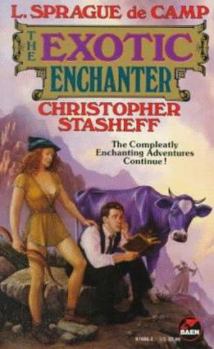The Exotic Enchanter
(Book #5 in the The Incompleat Enchanter Series)
Harold Shea, the incomplete Enchanter and his partner Reed Chalmers leap into the Russia of Prince Igor, where warriors pursue them through an Arabian Nightmare. To escape, they leap into the universe... This description may be from another edition of this product.
Format:Mass Market Paperback
Language:English
ISBN:067187666X
ISBN13:9780671876661
Release Date:May 1995
Publisher:Baen Books
Length:281 Pages
Weight:0.32 lbs.
Dimensions:0.8" x 4.3" x 6.9"
Customer Reviews
2 ratings
Bold new universes
Published by Thriftbooks.com User , 15 years ago
Exactly what's so "exotic" about this collection of original Harold Shea stories isn't entirely clear, but they're still fun. In the first, "Enchanter Kiev" by Roland Green & Frieda Murray, Shea and his mentor, Prof. Reed Chalmers, arrive unexpectedly in the Kievian Russia of the epic poem that inspired Borodin's opera "Prince Igor"--without Chalmers's wife Florimel, whom they spent most of the previous collection (Enchanter Reborn) trying to rescue from a sorcerous abductor. How and why they got separated isn't at first clear, though it's explained as the story goes on. Meanwhile the two psychologists meet the Prince and are mistaken for bogatyrs (Russian for "a warrior, a military commander, or an epic hero") who can assist him in his campaign against the Polovetsi horse barbarians--who, it turns out, have captured Florimel and plan to sell her into slavery. Even after they creatively trick the horsemen out of their captives, however, Shea and Chalmers discover that Florimel has once again disappeared, and in Christopher Stasheff's "Sir Harold and the Hindu King" they follow her to ancient India, specifically that of Bhavabhuti's collection of tales "Vikram and the Vampire," where they help the local rajah to stamp out a magically-augmented nest of thieves. This adventure finally reunites husband and wife, but in the third story, "Sir Harold of Zodanga," by L. Sprague deCamp, Shea is confronted by Florimel's persistent abductor, the sorcerer Malambroso, who declares that he is genuinely in love with her and asks Shea's help in persuading her to run away with him. When Shea refuses, Malambroso kidnaps Voglinda, the three-year-old daughter of Shea and his wife Belphebe, which, naturally, sends the worried parents in pursuit of him--to Barsoom ("not the real Mars, but the one [Edgar Rice] Burroughs imagined for his John Carter stories--or, to put it another way, the Mars in another universe, which somehow got into Burroughs' mind and formed the basis for his stories"). Here, assisted by Ras Thavas, THE MASTER MIND OF MARS (Martian Series #6), they travel across (or around) the planet by thoat and aircar and finally catch up to their offspring. In the final story, Tom Wham's "Harold Sheakspeare," the Sheas are attending a performance of A Midsummer Night's Dream (Signet Classics) when Shea's colleague Vaclav Polacek performs an ill-timed spell and drags them with him to Prospero's Isle--before Prospero got there. Confronted by legions of goblins in thrall to the witch Sycorax, the original inhabitant of the island, the Sheas undertake to help the good spirits banish them. There's plenty of swashbuckling action in these four stories, as well as the typical deCampian wry humor, ranging from jabs at human society in general to Shea's efforts to teach Ras Thavas how to be a "Barsoomian-of-the-world." And, yes, that *is* a purple cow on the cover, and there's a good reason for it to be there, but you'll have to read the fourth story to find
Deffinetly a good buy
Published by Thriftbooks.com User , 25 years ago
I've read christopher Stasheff before and this is just up his alley. It's interesting, well written, and excining. Deffinetly a good buy!






